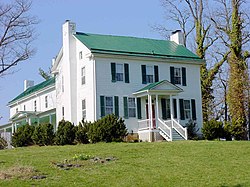Clarke County, Virginia | |
|---|---|
County | |
 Old Clarke County Courthouse and Confederate monument | |
 Location within the U.S. state of Virginia | |
 Virginia's location within the U.S. | |
| Coordinates: 39°07′N78°00′W / 39.12°N 78°W | |
| Country | |
| State | |
| Founded | 1836 |
| Named after | George Rogers Clark |
| Seat | Berryville |
| Largest town | Berryville |
| Area | |
• Total | 178 sq mi (460 km2) |
| • Land | 176 sq mi (460 km2) |
| • Water | 2.2 sq mi (5.7 km2) 1.2% |
| Population (2020) | |
• Total | 14,783 |
| • Density | 84.0/sq mi (32.4/km2) |
| Time zone | UTC−5 (Eastern) |
| • Summer (DST) | UTC−4 (EDT) |
| Congressional district | 6th |
| Website | clarkecounty |
Clarke County is a United States county located along the northern border of the Commonwealth of Virginia. Bordering West Virginia, Clarke County forms part of the Washington-Arlington-Alexandria, DC-VA-MD-WV Metropolitan Statistical Area. As of the 2020 census, the county had a population of 14,783. [1] Its county seat is the historic town of Berryville. [2]
Contents
- History
- Historic buildings and structures
- Geography
- Adjacent counties
- Government
- Board of Supervisors
- Constitutional officers
- Demographics
- 2020 census
- 2000 Census
- Transportation
- Major highways
- Service
- Communities
- Towns
- Census-designated place
- Other unincorporated communities
- Gallery
- See also
- References
- External links
The county was established in 1836 from part of Frederick County, and was named for Virginia Revolutionary War hero George Rogers Clark. Historically agrarian, Clarke County is one of the most sparsely populated areas of Northern Virginia.
















